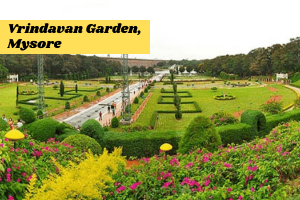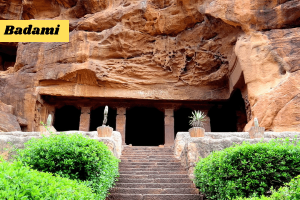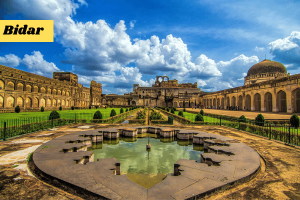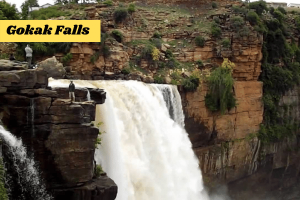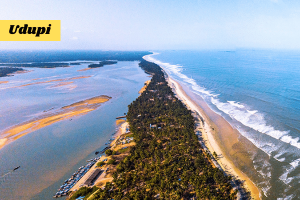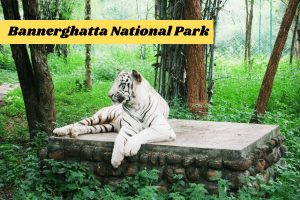is the eighth largest state by population and is a home to a variety of wildlife
Karnataka is a state in the south western region of India. It was formed on 1 November 1956, with the passage of the States Reorganisation Act. Originally known as the State of Mysore, it was renamed Karnataka in 1973.The capital and largest city is Bangalore (Bengaluru). Karnataka is bordered by the Arabian Sea and the Laccadive Sea to the west, Goa to the northwest, Maharashtra to the north, Telangana to the northeast, Andhra Pradesh to the east, Tamil Nadu to the southeast, and Kerala to the southwest. The state covers an area of 191,976 square kilometres (74,122 sq mi), or 5.83 percent of the total geographical area of India. It is the seventh largest Indian state by area. With 61,130,704 inhabitants at the 2011 census, Karnataka is the eighth largest state by population, comprising 30 districts. Kannada, one of the classical languages of India, is the most widely spoken and official language of the state.
| Area | 191,791 sq km |
|---|---|
| Capital | Bangalore (Bengaluru) |
| Population | 61,130,704 |
| Official Languages | Kannada |
| Boundary | Karnataka is bordered by the Arabian Sea and the Laccadive Sea to the west, Goa to the northwest, Maharashtra to the north, Telangana to the northeast, Andhra Pradesh to the east, Tamil Nadu to the southeast, and Kerala to the southwest. |
Karnataka Has A Multi-religious And A Multi-cultural Population. Hence A Variety Of Festivals Are Held In The State. Karnataka Like Most Of Its Southern Neighbors Has Several Temples Which Also Account For A Number Of Festivals Being Held Each Year. Dusshera, The Most Important Hindu Festival Is Celebrated With Extravagance Over A Period Of Ten Days. This Festival Was Started By The Rulers Of The Vijaynagar Empire. Other Festivals Celebrated In Karnataka Are Yugadi, Karaga Celebrated At The Darmaraya Temple And Rajyotsava Day. Makara Samkramana, Sri Ramanavami, Sri Krishna Janmashtami, Ganesh Chaturthi And Deepavali Are The Other Festivals Celebrated In Karnataka Along With The Rest Of The Country. The Fairs Which Are Held In Karnataka Are Sri Vithappa Fair, The Godachi Fair, Shri Yellamma Devi Fair And Banashankari Devi Fair
With A Strong Lineage Of Indian Emperors Ruling This State, The Culture Of Karnataka Has Been Shaped By Like Mauryas, Chalukyas The Hoysalas, And The Vijayanagar Empire. They Have Left Behind A Rich Cultural Heritage That Is Still Evident In The Everyday Life. Karnataka Is Also Home Of Various Tribes Like Kodavas, Konkanis, And Tuluvas. The Beautiful Land Has Been Blessed With Timeless Monuments, World Heritage Sites, Luscious Green Forest, Marvelous Wildlife, Romantic Hill Stations, Stunning Beaches And Vibrant Culture That Resonates It All. The Diversity It Offers In Terms Of The Language, Arts, Crafts And Festivals Is Astounding. The Royal Patronage Of The Vijaynagar Empire Has Left A Long Vivacious History And Illustrious Landmarks That Has Led To Them Being Declared As World Heritage Sites. The ‘art’ And ‘craft’ Work Of Karnataka Is Evident In Every Sphere Of Our Daily Lives. Read On To Find Out More About This Rich Cultural Land.
The Cuisine Of Karnataka Includes Many Vegetarian And Non-vegetarian Cuisines. The Kannada Cuisine Is One Of The Oldest Surviving Cuisines And Traces Its Origin To Iron Age – Ragi And Is Mentioned In The Historical Works By Pampa Maha Kavi, Sushrutha, Etc. The Varieties Of The Karnataka Cuisine Has Influenced The Neighbouring States Like Tamil Nadu, Andhra Pradesh, Kerala And Maharashtra. The Cuisine Also Reflects Influences From The Food Habits Of Many Regions And Communities From The Three Neighbouring South Indian States, As Well As The State Of Maharashtra To Its North. Some Typical Dishes Include Bisi Bele Bath, Jolada Rotti, Chapati, Ragi Rotti, Akki Rotti, Saaru, Idli-vada Sambar, Vangi Bath, Khara Bath, Kesari Bath, Benne Dose, Neer Dose, Ragi Mudde, Paddu/ Gundponglu, Koli Saaru (chicken Curry- Kannada Style), Maamsa Saaru (mutton Curry – Kannada Style), And Uppittu. The Famous Masala Dose Traces Its Origin To Udupi Cuisine. Plain And Rave Idli, Mysore Masala Dosa And Maddur Vade Are Popular In South Karnataka. Kodagu (coorg) District Is Famous For Spicy Varieties Of Pork Curries While Coastal Karnataka Boasts Of Many Tasty Seafood Specialities. Among Sweets, Mysore Pak, Holige, Or, Obbattu, Dharwad Pedha, Chiroti, Sajjige, Kadabu/ Karjikaayi Are Well Known.
Although The Ingredients Differ From One Region To Another, A Typical Kannadiga Oota (kannadiga Meal) Includes The Following Dishes In The Order Specified And Is Served On A Banana Leaf: Uppu (salt), Kosambari, Pickle, Palya, Gojju, Raita, Dessert, Thovve, Chitranna, Rice And Ghee.
After Serving Ghee To Everyone, One May Start The Meal. This Is Done To Ensure That Everyone Seated Has Been Served All The Dishes Completely.
Obbattu ( Holige ) Fenugreek Akki Rotti With Ghee And Peanut Coconut Chutney
What Follows Next Is A Series Of Soup Like Dishes Such As Saaru, Muddipalya, Majjige Huli Or Kootu Which Is Eaten With Hot Rice. Gojju Or Raita Is Served Next; Two Or Three Desserts Are Served; Fried Dishes Such As Aambode Or Bonda Are Served Next. The Meal Ends With A Serving Of Curd Rice.
There Is Some Diversity In Core Food Habits Of North And South Karnataka. While Northern-style Dishes Have Jola And Rice As The Primary Cereals The South Uses Ragi And Rice.
The Beautiful State Of Karnataka Is Dotted With Numerous Monuments And Heritage Properties Which Signify That It Has Been A Place Of Royal Families And Kings. The Royalty Of Karnataka And Its Rich Culture Can Further Be Observed In The Forms Of Its Rich Art And Crafts. The Art Of Making Crafts In Karnataka Has Passed From Generation To Another Thus Making It More Like A Tradition. Almost Every Region In Karnataka Is Renowned For Some Kind Of Exclusive Crafts Like Mysore Is Well Known For Its Paintings And Silk While Udipi Is Famous For Its Metal Works. Important Of Handicrafts Arts And Crafts In Karnataka Have Always Been An Inseparable Element From The Life Of Its Native People. Since Ancient Time, The State Of Karnataka Has Gained Immense Popularity For Its Crafts And Is Still Today Occupies An Imperative Position With Respect To Art And Crafts. One Of The Major Factors That Distinguish The Crafts Of Karnataka From Others Is The Significant Reliance Of People On Traditional Method Of Producing Crafts. In The Recent Years, The Government Has Also Come Up To Support And Encourage Traditional Art And Craft And Thus Many People Now Are Associating Their Self With Crafts Making. Wood Works Wood Works In Karnataka Is An Ancient And A Popular Craft Of The State That Has Evolve For Many Centuries. The Most Impressive Wood Work Or Carvings Can Be Seen In The Temple That Adorns The Charm And Grandeur Of Karnataka. The Exquisite Carvings Done On The Wooden Doors And Ceiling Are Indeed Remarkable And Deserves Great Appreciation. Idols Of Gods Carved Out Of Wood Are Most Common In The State That Can Be Seen In Almost All Household. Sandalwood That Are Used To Produce Beautiful Art Pieces Like Lamp Shades, Decorative Articles, Images Of Lord Krishna Are Very Popular Crafts That Allures Every Tourist To The State. Mysore Silk Silk Is Considered As The Major Export Material Of Karnataka. Mysore Is Often Accredited As The Main Hub For Producing Mulberry Silk In The State. Production Of Mulberry Silk In Mysore Is Not New Rather It Is Said That This Enchanting Destination Was Known For Silk Since The Reign Of Tipu Sultan. Numerous Items Are Made From The Silk Like Silk Sari And Silk Shawls Which Are Quite A Popular Products Among The Female Travellers In The State. Metal Ware Metal Work In Karnataka Is Performed Across Its Different Parts. Some Of The Places In The State Are Well Known For Brass Casting While Others Have Gained Immense Reputation For Metal Works. Numerous Religious Articles Are Made From Metals. Udipi Is Regarded As The Hub Of Metal Works In The State While Mangalore Is Famous For Its Bell Metal And Nagamangala For Its Bronze Casting. Mysore Paintings One Of The Oldest Forms Of Art That Has Passed From Generation To Another Is Probably The Mysore Paintings. It Is Often Claimed That The Art Of Paintings Initiated In Mysore Way Back During The Ajanta Period. Vijayanagara Dynasty Is Recognised As To Have Significant Contribution In The Flourishing Of Paintings Arts In The State. Even Today, Paintings In Mysore Are Made Using Traditional Methods That Involves Extensive Use Of Lustrous Gold Leaf And Bright Colours Making Its Unique And Exquisite. Ivory And Stone Carving The State Of Karnataka Is Also Earned Immense Reputation For Its Ivory Carvings Across The World. Ivory Carvings Are Delicately Performed To Create Figures Of Deities. Similarly Stone Carvings In The State Are Also Considered As Another Popular Craft. The Skills Of Craftsmanship Related To Stone Carvings Can Be Widely Seen In Temples And Idols.
Telephone Access code : ++91 836
Bus – There are regular buses to Bangalore (9 hr) and Hospet (4 hr). KSRTC (five daily) and Goa Kadamba bus company buses go to Goa daily. There are also buses to Mumbai (15 hr), Mangalore (10 hr), Jog Falls, Gokarna, Mysore (10 hr), and Bijapur. Across from the bus stand are private bus companies offering deluxe buses to Goa, Bangalore, Pune, Mangalore, Mumbai, and Bijapur. Hubli has a large and busy bus station. Buses to Panaji take 11 hours and leave 3 times a day.

